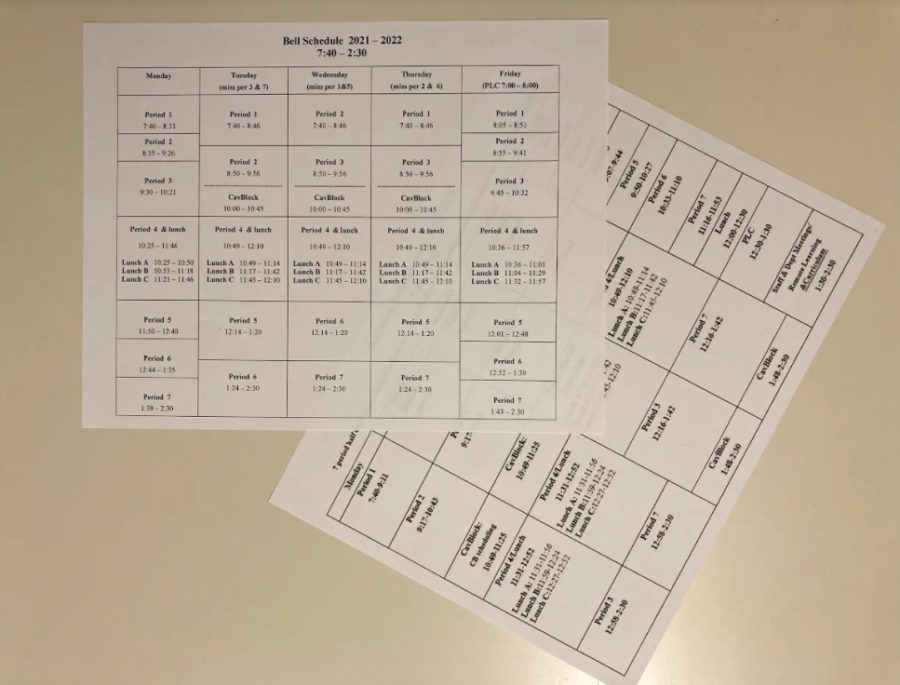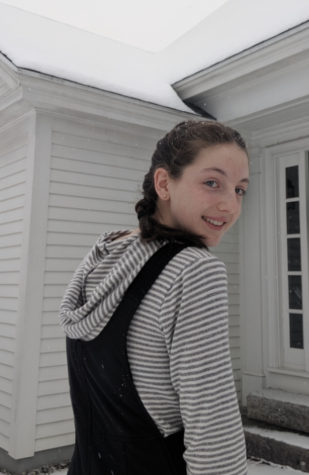Opposing Schedules Take On HB
October 8, 2021
As students flock back to school accompanied by a decline in COVID guidelines, debate arises surrounding the return to Hollis Brookline High School’s previous schedule for the 2021-2022 school year. The COVID-19 pandemic forced Hollis Brookline to adapt the schedule last year to include less transitions with only four blocks a day, CavBlock four days a week, and half days on Friday. However, with the return to normalcy as COVID guidelines decrease, HB has reinstated the current schedule that consists of five classes a day, CavBlock three times a week and PLC on Fridays.
The decision to return to the current schedule has affected both students and staff, as both sides have had to consider the benefits and drawbacks of how their days are structured. The current schedule allows classes to meet more frequently, giving students the opportunity to meet with teachers almost everyday throughout the week. “I teach an AP class, and for that class it’s much better to have this year’s schedule because I see the kids,” said Judith McDaniel, a math teacher at HB.
Meeting face to face with so many classes a day also provides variety, said Ausyn Kump ‘23 about the current schedule, something that was restricted in the COVID schedule.
Having more classes a day can also mean more homework though, as students have to finish assignments out of class. “I have to time management a lot more,” said Kump, explaining how having so many classes a day affects her work load. However, only meeting with classes three times a week can inadvertently cause procrastination, especially when students believe they have more time to get work done.
The current schedule also requires attendance in CavBlock, something that has increased student participation, said both social studies teacher Jennifer Given and McDaniels. However, the COVID schedule presented students with the option to participate in CavBlock four days a week instead of three. This was very helpful for students who took advantage of it, especially those in Honors and AP courses. “We had an additional CavBlock in that schedule that was a really big help… as an AP teacher it’s really helpful to have that one extra block,” said Given.
CavBlock was previously at the end of the day in the COVID schedule, changing dismissal times for students based on whether or not they chose to leave early. This year all students leave at the same time, not including sports or other exceptions, affecting traffic patterns at the end of the day. This change is partly due to the large number of students leaving the building at once, instead of in waves. “It makes it a little bit easier when it’s [CavBlock] at the end of the day because you can either leave early and have a little bit less traffic or leave late and have no traffic,” said Megan King ‘23.
The most dramatic difference, however, is the length of classes and instructional time. Due to only meeting with selected classes a day last year, similar to a college schedule, classes were extended. This meant increased class periods, lecture times, and the ability to complete more work in class. “It’s much more manageable… the fact that you transitioned less times in a day like you switch what you’re doing less frequently I think really helps people with being able to process what they’re learning, what they’re talking about, I think that has a huge benefit,” said Given. The long blocks also give teachers the opportunity to attempt new lesson styles, or activities. “You can do different types of lessons where, in the time constraint of the short periods, you just can’t pull off,” said Given.
Long blocks can be difficult to sit through, however, especially in courses that mainly consist of lecturing or repeated practice elements. “There’s only so much you can absorb in a class session and you still have to get through the same amount of material each week,” said McDaniels. The COVID schedule addressed this in the form of mask breaks, which broke up the day with an opportunity to move, especially in the warmer months. The current schedule on the other hand automatically breaks up these classes, and provides opportunities for students to move between classes.
Both schedules offer a series of difficulties and benefits, however, Given, Kump, and McDaniels all agreed that experiencing two different schedules has helped their understanding of block schedules. Given and Kump also both agreed that their ideal schedule would potentially include a combination of the two schedules we have had, opening up an interesting discourse.
Despite the differing schedules, HB students can still look forward to the same scheduled breaks and days off throughout the rest of the year with a long weekend approaching on Oct 11.














